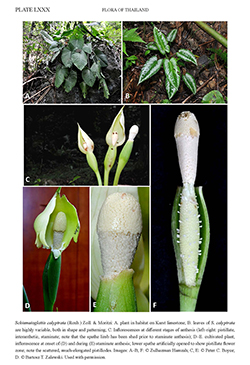e-Flora of Thailand
Volume 11 > Part 2 > Year 2012 > Page 288 > Araceae > Schismatoglottis
2. Schismatoglottis calyptrata (Roxb.) Zoll. & Moritzi
in M.Moritzi, Syst. Verz.: 83. 1846; Schott, Syn. Aroid.: 120. 1856; Schott, Prodr. Syst. Aroid.: 321. 1860; Engl. in A.DC. & C.DC., Monogr. Phan. 2: 352. 1879; Ridl., Mat. Fl. Malay Penins.: 31. 1907; Engl. & Krause in Engl., Pflanzenr. IV, 23Da (Heft 55): 114. 1912; Ridl., Fl. Malay Penins. 5: 111. 1925; Gagnep. in Lecomte, Fl. Indo-Chine 6: 1117–1118. 1942; Hay, Sandakania 7: 11. 1996; Hay & Yuzammi, Telopea 9(1): 106–117. 2000; Li & Boyce in H.Li. et al., Fl. China 23: 19–20. 2010.—Calla calyptrata Roxb., Fl. Ind. 3: 514. 1832.— Homalomena calyptrata (Roxb.) Kunth, Enum. Pl. 3: 57. 1841.— Zantedeschia calyptrata (Roxb.) K.Koch, Ind. Sem. Hort. Berol. App.: 9. 1854. Plate LXXX.
Accepted Name : This is currently accepted.
Description : Stoloniferous herb forming colonies, or clump-forming, 15–60 cm tall. Stems hypogeal, hapaxanthic, 1–2 cm diam. Leaves several together; petiole smooth, ca 5–50 cm long (often less); petiolar sheath for ca ⅓ its length; wings of sheath fully attached, persistent, tapering or, especially in diminutive forms, shortly and bluntly ligular at the apex; leaf blade mostly cordate to sagittate, sometimes oblong-lanceolate, 7–35 by 4–18 cm, usually dull mid green, sometimes variegated with 1–2 bands or irregularly spotted grey-green to yellowish green; midrib somewhat abaxially prominent; primary lateral veins 6–15 per side, irregularly alternating with lesser interprimaries, nearly always raised adaxially towards the midrib, marginally impressed, entirely raised abaxially; secondary venation arising mostly from the midrib, sometimes from the bases of the primary veins; tertiary venation inconspicuous. Inflorescences 1–8 together, with a strong esteric odour at pistillate anthesis; peduncle 2–14 cm, erect at anthesis, then deflected; spathe 3.5– ca 12 cm long; lower spathe narrowly ovoid, ca half the length of the whole spathe, green, often minutely longitudinally ridged and rough; spathe limb differentiated from lower spathe by an abrupt constriction corresponding to the base of the staminate zone of the spadix, at pistillate anthesis much inflated, narrowing and turbinate, the apex conspicuously mucronate, completely surrounding the spadix and gaping ventrally or with the margins loosely overlapping, creamy to pale greenish yellow, caducous immediately after pistillate anthesis; spadix ca ¾ the length of the spathe, narrowly hourglass-shaped; pistillate flower zone about half the length of the whole spadix, sessile, somewhat to markedly obliquely inserted to partially adnate to spathe, ca 5–8 mm diam. below, distally tapering to ca 3–4 mm diam.; ovaries flask-shaped, ca 1 mm by 0.5 mm diam.; stigmas button-like, papillate, raised on a short style; interpistillar staminodes white, mostly conspicuously taller than pistils, few in number, scattered, stalked, clavate, rarely absent in very small forms; sterile interstice between staminate and pistillate zones absent save sometimes for a relative concentration of interpistillar staminodes amongst the distal pistils; staminate flower zone narrowly obconical, approximately half the length of the pistillate zone, distally ca 0.5–1 cm diam., ivory; anthers dumbbell-shaped from above, ca 0.5 by 1 mm, with thecae apically impressed, the connective shorter than to very slightly elevated above the thecae; appendix bullet-shaped to hemispherical, basally nearly always somewhat wider than apex of staminate zone, creamy yellow; appendix staminodes columnar, irregularly polygonal, flat- to slightly round-topped, ca 0.5 mm diam. Fruiting spathe declinate, urceolate.
Thailand : PENINSULAR: Nakhon Si Thammarat, Narathiwat.
Distribution : Tropical SW China to Indochina east through Maluku (type) to Vanuatu, throughout except for extremely seasonal areas.
Ecology : Damp to everwet evergreen lowland forests.
Vernacular : Bon khiao (บอนเขียว)(Peninsular).
Notes: This species is distinguished in Thailand by the combination of hapaxanthic, hypogeal stems and stoloniferous, often colony-forming terrestrial habit, clustered inflorescences and the dome-shaped appendix slightly and abruptly wider than the top of the staminate zone.
Typically, local ‘populations’ are strikingly uniform, and frequently seem rather sharply differentiated from adjacent ones. This may well be a result of the colonial habit of this species enabling the formation of very extensive, long-lived clonal ‘superindividuals’.
See Hay & Yuzammi [Telopea 9(1): 1–177. 2000] for a detailed discussion of the extensive synonymy.

